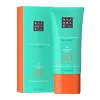What's inside
What's inside
 Key Ingredients
Key Ingredients

 Benefits
Benefits

 Concerns
Concerns

 Ingredients Side-by-side
Ingredients Side-by-side

Water
Skin ConditioningC12-15 Alkyl Benzoate
AntimicrobialGlycerin
HumectantIsopropyl Palmitate
EmollientButyl Methoxydibenzoylmethane
UV AbsorberEthylhexyl Salicylate
UV AbsorberBis-Ethylhexyloxyphenol Methoxyphenyl Triazine
Skin ConditioningEthylhexyl Triazone
UV AbsorberCetearyl Alcohol
EmollientPotassium Cetyl Phosphate
EmulsifyingTocopheryl Acetate
AntioxidantNelumbo Nucifera Flower Extract
Skin ConditioningCamellia Sinensis Leaf Extract
AntimicrobialNannochloropsis Oculata Extract
HumectantPorphyra Umbilicalis Extract
Skin ConditioningAloe Barbadensis Leaf Extract
EmollientSilybum Marianum Seed Oil
Skin ConditioningSqualane
EmollientParfum
MaskingDiethylhexyl Butamido Triazone
UV AbsorberGlyceryl Stearate
EmollientXanthan Gum
EmulsifyingPhenylbenzimidazole Sulfonic Acid
UV AbsorberPolyglyceryl-2 Dipolyhydroxystearate
Skin ConditioningAcacia Senegal Gum
MaskingAspartic Acid
MaskingAlcohol
AntimicrobialCaprylyl Glycol
EmollientCaprylhydroxamic Acid
Benzyl Alcohol
PerfumingBenzyl Salicylate
PerfumingLimonene
PerfumingLinalool
PerfumingHexyl Cinnamal
PerfumingAlpha-Isomethyl Ionone
PerfumingCitronellol
PerfumingCitral
PerfumingAminomethyl Propanol
BufferingTetrasodium Iminodisuccinate
Fumaric Acid
BufferingMaleic Acid
BufferingMalic Acid
BufferingWater, C12-15 Alkyl Benzoate, Glycerin, Isopropyl Palmitate, Butyl Methoxydibenzoylmethane, Ethylhexyl Salicylate, Bis-Ethylhexyloxyphenol Methoxyphenyl Triazine, Ethylhexyl Triazone, Cetearyl Alcohol, Potassium Cetyl Phosphate, Tocopheryl Acetate, Nelumbo Nucifera Flower Extract, Camellia Sinensis Leaf Extract, Nannochloropsis Oculata Extract, Porphyra Umbilicalis Extract, Aloe Barbadensis Leaf Extract, Silybum Marianum Seed Oil, Squalane, Parfum, Diethylhexyl Butamido Triazone, Glyceryl Stearate, Xanthan Gum, Phenylbenzimidazole Sulfonic Acid, Polyglyceryl-2 Dipolyhydroxystearate, Acacia Senegal Gum, Aspartic Acid, Alcohol, Caprylyl Glycol, Caprylhydroxamic Acid, Benzyl Alcohol, Benzyl Salicylate, Limonene, Linalool, Hexyl Cinnamal, Alpha-Isomethyl Ionone, Citronellol, Citral, Aminomethyl Propanol, Tetrasodium Iminodisuccinate, Fumaric Acid, Maleic Acid, Malic Acid
 Reviews
Reviews

Ingredients Explained
These ingredients are found in both products.
Ingredients higher up in an ingredient list are typically present in a larger amount.
Parfum is a catch-all term for an ingredient or more that is used to give a scent to products.
Also called "fragrance", this ingredient can be a blend of hundreds of chemicals or plant oils. This means every product with "fragrance" or "parfum" in the ingredients list is a different mixture.
For instance, Habanolide is a proprietary trade name for a specific aroma chemical. When used as a fragrance ingredient in cosmetics, most aroma chemicals fall under the broad labeling category of “FRAGRANCE” or “PARFUM” according to EU and US regulations.
The term 'parfum' or 'fragrance' is not regulated in many countries. In many cases, it is up to the brand to define this term.
For instance, many brands choose to label themselves as "fragrance-free" because they are not using synthetic fragrances. However, their products may still contain ingredients such as essential oils that are considered a fragrance by INCI standards.
One example is Calendula flower extract. Calendula is an essential oil that still imparts a scent or 'fragrance'.
Depending on the blend, the ingredients in the mixture can cause allergies and sensitivities on the skin. Some ingredients that are known EU allergens include linalool and citronellol.
Parfum can also be used to mask or cover an unpleasant scent.
The bottom line is: not all fragrances/parfum/ingredients are created equally. If you are worried about fragrances, we recommend taking a closer look at an ingredient. And of course, we always recommend speaking with a professional.
Learn more about Parfum